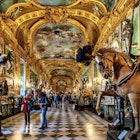
Mar 11, 2022 • 5 min read

Apr 20, 2022 • 4 min read

Installation view of the gallery In Solidarity (Gallery 507). The Museum of Modern Art, New York. Digital Image © 2022 MoMA, N.Y. Photo by Robert Gerhardt
Under the banner “In Solidarity,” Manhattan’s Museum of Modern Art has dedicated a collection gallery to works by artists born in present-day Ukraine.
The gallery debuted on MoMA’s fifth floor in late March, highlighting pieces in multiple mediums from artists of varying backgrounds, including the renowned New York street photographer Weegee, aka Arthur Fellig, born in what was then Austria-Hungary (later Poland, and eventually Ukraine); the avant-garde Russian painter Kazimir Malevich, born in Kyiv; and the Russian sculptor Louise Nevelson, known for her monochromatic wood installations, also born in Kyiv.
In a region where international borders shift with the political winds, it’s no surprise that many of the artists featured have Russian, Soviet, and Polish roots. But you won’t find those origins noted in the display copy – a conscious decision on the part of the curatorial team. “Nationality, which so happens to be where a person’s passport is, doesn’t given the full picture,” MoMA’s chief curator of painting and sculpture, Ann Temkin, told ARTnews.

As the gallery’s wall text explains, some of the featured artists grew up in Kyiv; others wound up in creative hubs like Paris, Berlin, Moscow and – particularly those of Jewish descent seeking refuge from persecution – New York. But they were all brought together here “as a statement of solidarity with, and in tribute to, the people of Ukraine.”
Since the Russian attack, museums from Lviv to Kharkiv to Kyiv have been working to secure their treasures, hastily taking down exhibitions and moving art and artifacts to safety, be it in underground bomb shelters or safe hands overseas.
At the literary museum in Kharkiv, director Tanya Pylypchuk told Time, “the most valuable part of the collection” – including documentation that showed “Ukraine wanted to be part of Europe, not Russia” – was shifted to a bunker shortly after the war began. “Such materials were banned in the Soviet Union…. Modern Russia also does not accept this version of Ukrainian history.”
“This is a war against our history, our culture,” Ihor Poshyvailo, director of Kyiv’s Maidan museum, added to Time.
On the ground, Ukrainian communities are mobilizing to protect both that heritage and their artistic future, from the concerned citizens in Lviv who wrapped the city’s centuries-old statues in plastic to the curator who managed to get the “unique artwork” created for this year’s Venice Biennale across the border to Poland – in the back seat of her car.

And they’re not just keeping an eye on Ukrainian artifacts. Back in March, with the city under siege, employees at the Kharkiv Art Museum put themselves at risk to keep the 25,000-item collection – which boasts a not-insignificant number of pieces from Russian artists – safe from the shelling. “It is simply irony of fate that we should be saving Russian artists, paintings by Russian artists from their own nation,” the museum’s foreign art department head, Maryna Filatova, told Reuters.
In the cultural sector, there’s been no shortage of outrage over the invasion, with artists of all stripes voicing their objections. Famed cellist Yo-Yo Ma, for one, took to the sidewalk in front of the Russian Embassy in Washington, DC, to perform in unpublicized protest, complete with a sign reading Zelensky Way. “The thing I remember him saying was ‘everyone has to do something,'” the eagle-eyed cyclist who spotted the musician told a local TV station. “It’s meaningful for him, without an audience, to make a statement.”
A few days earlier in the Big Apple, a group of Ukrainian New Yorkers staged a protest at the Guggenheim, releasing hundreds of paper planes bearing anti-war messages from the top of the museum’s spiral ramp to the floor below. “We wanted to show people what it feels like when danger comes from the sky,” one of the organizers, Lika Volk, explained to Bloomberg. “We are asking the West to just do something.

While various international artists have pulled out of shows in Russia or declined future collaborations, and some of the art world’s most venerable institutions have cut ties with oligarch donors and trustees, MoMA’s In Solidarity gallery seems to be the rare artistic response from a major museum.
“There are many, many ways that one can help materially, through donations and through other means of directly contributing, but then there’s another part of you that has the desire to acknowledge the people whose lives are being forever changed, even if it’s not a way that physically or materially helps,” Temkin told ARTnews.
Its permanent-collection galleries often change on a seasonal basis, but this isn’t the first time New York’s elder statesman of modern art has rearranged its fifth-floor displays for a cause. To protest President Trump’s travel ban, the museum rehung pieces from its permanent collection by artists from the majority-Muslim nations no longer welcome in the US, the New York Times reported in 2017.
“A number of artists in our collection suddenly couldn’t travel the way they used to and share their work and ideas,” MoMA’s chief curator of drawings and prints, Christophe Cherix, told Quartz at the time. “We wanted to reaffirm that belief that art [museums] should be a place where people from all over the world can gather.”
You might also like:
Standing with Ukraine: two ways to offer support
Thoughts on Ukraine: Friday around the Planet
How to download Lonely Planet's Ukrainian phrasebook for free


Mar 11, 2022 • 5 min read

Apr 22, 2021 • 2 min read






